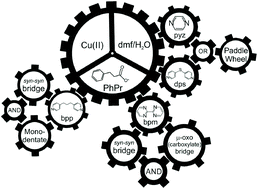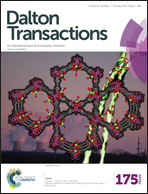Magneto-structural versatility of copper(ii)-3-phenylpropionate coordination polymers with N-donor coligands†
Abstract
A novel series of copper(II) coordination polymers [Cu2(O2CC8H9)4(pyz)]n (1), [Cu2(O2CC8H9)4(dps)]n (2), {[Cu(O2CC8H9)2(dps)(H2O)]·H2O}n (3), {[NaCu(O2CC8H9)2(bpm)(NO3)]·H2O}n (4), and [Cu4(O2CC8H9)6(OH)2(bpp)2]n (5) [O2CC8H9− = 3-phenylpropionate anion, pyz = pyrazine, dps = di(4-pyridyl)sulfide, bpm = 2,2′-bipyrimidine, and bpp = 1,3-bis(4-pyridyl)propane] have been synthesized and magneto-structurally investigated. Compounds 1 and 2 belong to a large group of copper(II) carboxylates where bis-monodentate pyz (1) and dps (2) ligands connect the paddle-wheel [CuII2(μ-O2CC8H9)4] units leading to alternating copper(II) chains. The structure of 3 consists of uniform chains of trans-[CuII(O2CC8H9)2] units linked by the bis-monodentate dps ligand. Compound 4 consists of heterobimetallic chains where [NaI2CuII2(μ-O2CC8H9)4(NO3)2] units are doubly bridged by bis-bidentate bpm ligands. Compound 5 is also a chain compound whose structure is made up by tetranuclear [CuII4(μ3-OH)2(μ-O2CC8H9)4(O2CC8H9)2] units which are doubly bridged by bis-monodentate bpp ligands. The magnetic properties were investigated in the temperature range 1.8–300 K. Strong antiferromagnetic interactions across the quadruple syn–syn carboxylate are observed in 1 and 2 [J = −378 (1) and −348 cm−1 (2)] whereas a weak ferromagnetic coupling through the double out-of-plane oxo(carboxylate) bridge occurs in 4 [J = +2.66 cm−1], the spin Hamiltonian being defined as H = −JS1·S2 with S1 = S2 = SCu = 1/2. A quasi Curie law is observed for 3 (θ = −0.36 cm−1), the bis-monodentate dps ligand being a very poor mediator of magnetic interactions. The analysis of the magnetic properties of 5 is quite complex because of the presence of two crystallographically independent tetracopper(II) units with single-μ-hydroxo, di-μ-hydroxo, μ3-hydroxo and single-μ-hydroxo plus double syn,syn carboxylate bridges in each one. The nature and values of the magnetic couplings for 5 obtained by fitting (intermediate, strong and weak antiferromagnetic interactions for the three former exchange pathways respectively, and intermediate ferromagnetic interactions for the latter one) were substantiated by DFT type calculations.


 Please wait while we load your content...
Please wait while we load your content...